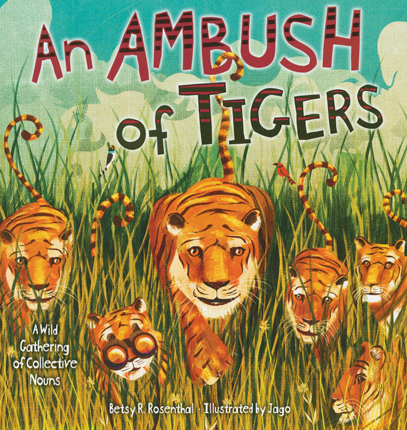Full Text Reviews: School Library Journal - 02/01/2015 K-Gr 3—Collective noun books have been multiplying this past decade, and this compendium of poetry stands out for its artistry and creativity. Each collective noun couplet whimsically describes a group of animals: "Would a labor of moles/wear polka-dot ties/when it goes to work/for a business of flies?" The laugh-out-loud illustrations depict the events described, often serving as strong mnemonic devices: a "rumba of snakes" dances; a "bouquet of pheasants" sprout from a vase; the ambush of tigers creep across the grass, tails curled high in the air, sights set on the horizon; and a "bed of oysters" literally rest on a bed, snoozing away. The writing is pithy, with an iambic thrum that make memorization easy. VERDICT This crash course in juxtaposition and imagination should be celebrated with a peal of bells. An inspiring addition to any poetry collection.—Teresa Pfeifer, The Springfield Renaissance School, Springfield, MA - Copyright 2015 Publishers Weekly, Library Journal and/or School Library Journal used with permission. Booklist - 04/01/2015 Collective nouns for animals range from the humdrum and vaguely familiar (“a pack of wolves” and “a string of ponies”) to the colorful, off-the-wall, and hard to believe someone’s not just making these things up (“a bouquet of pheasants,” “a mischief of rats,” and “an intrusion of roaches”). In this inventive picture book, 33 animal-themed collective nouns become springboards for the writer’s imagination and the illustrator’s creativity. Each double-page spread carries one or two rhyming verses posing questions related to certain collective nouns, such as, “When a murder of crows / leaves barely a trace, / is a sleuth of bears / hot on the case?” Rosenthal’s logical pairings and absurd hypothetical situations are well matched by the dynamic digital illustrations. Jago uses structure, color, and repeated forms well, creating pictures that reward close attention with amusing details. An appended glossary brings all the collective nouns together, defines them, and asks kids to guess why each is well suited to the corresponding animal. A lively picture book with plenty of classroom potential. - Copyright 2015 Booklist. Bulletin for the Center... - 07/01/2015 “Do you ever wonder what animals do/ when they gather in groups of more than two?” queries the author in this clever contemplation of animal-centric collective nouns. Some of the text’s rhyming questions are relatively straightforward (“Does a pack of wolves/ load up bags for vacation?// Does a cast of hawks/ get a standing ovation?”), while others are more complex: “Would a labor of moles/ wear polka-dot ties// when it goes to work/ for a business of flies?” While this is basically a list of collective nouns, the rhythmic text is inventively and captivatingly composed, and the rhyme scheme is consistent and effective. Jago’s digital illustrations are equally intriguing in their imaginative visualization of the text. The stylized figures and rich backgrounds in faux-linen texturing have subtle layers of patterning or color embellishing the art. Some amusingly depict the literal meaning of the collective noun, such as the “stench” of skunks surrounded by a marbleized, translucent green fog as the “band” (as in “rock band”) of gorillas holds its noses in dismay, or the sash-clad “troop” of kangaroos selling Girl Scout–style boxes of cookies. A glossary listing each collective noun’s more customary definition (e.g., “labor (moles): to work hard”) is also included. Language arts teachers as well as librarians will want to get their paws on this title. JH - Copyright 2015 The Board of Trustees of the University of Illinois. Loading...
|



